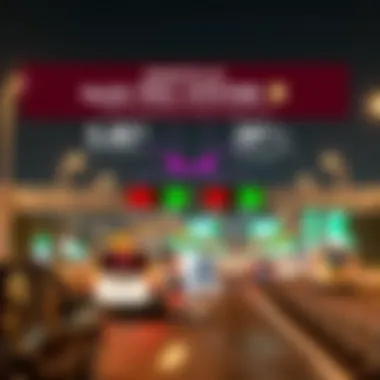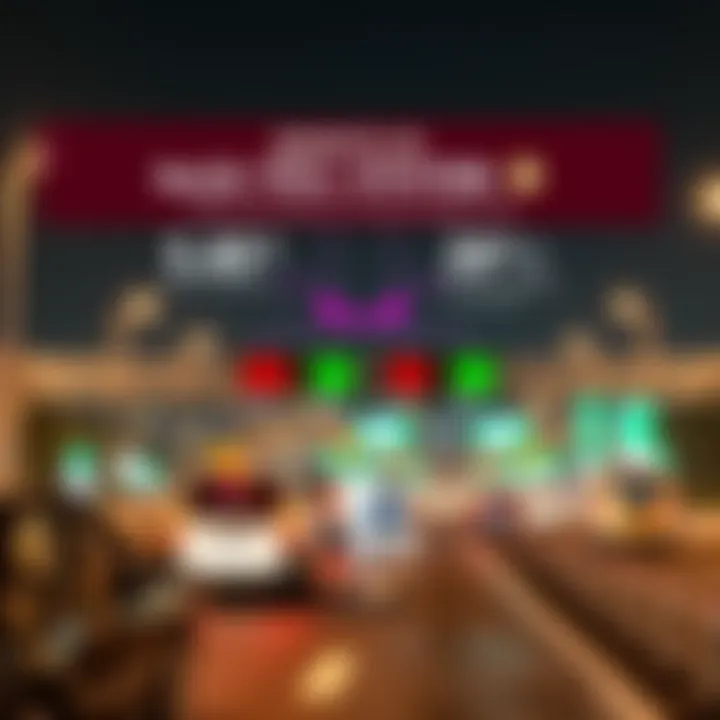Understanding the Salik Toll System on Sheikh Zayed Road


Intro
Navigating the labyrinth of Sheikh Zayed Road can be quite the task, especially with the Salik toll system in place. As anyone who’s driven along this bustling route knows, understanding how Salik operates can greatly impact your travels. This toll system isn’t just a mere inconvenience; it plays a pivotal role in shaping traffic trends, urban development, and even the local economy.
In this article, we’ll peel back the layers surrounding the Salik toll system. You will gain insight into its operational mechanics, the technology behind its implementation, and how it affects not just your pocket, but also the very fabric of urban life in Dubai. Along the way, we’ll delve into real user experiences and concrete examples that illustrate the system’s reach.
The relevance of this discussion extends beyond mere cost considerations. For residents, investors, and businesses operating in the area, Salik represents a significant factor in daily decision-making, whether it's choosing a route, planning a commute, or understanding local market dynamics. Stick with us as we unravel what Salik truly means for motorists and urban planners alike.
The Salik Toll System Overview
The introduction of the Salik toll system along Sheikh Zayed Road marks a significant shift in how Dubai manages its urban transportation. Attempting to alleviate congestion, improve traffic flow, and generate revenue for vital infrastructure, Salik serves multiple functions within the larger framework of the city. Understanding this system is crucial not only for everyday motorists but also for businesses, investors, and urban planners, as it directly impacts daily commutes and economic activities.
Prolusion to Salik
Salik, meaning "clear" in Arabic, represents a shift towards more organized road usage in the bustling metropolis of Dubai. Launched in 2007, the system employs a straightforward electronic toll collection process. This eliminates the cumbersome need for cash transactions. An electronic tag, affixed to vehicles, automatically deducts the toll fees when passing through designated points, allowing traffic to flow smoothly without significant interruptions. The convenience can’t be overstated; it’s a game-changer for those who navigate the busy streets on a daily basis. Today, understanding how this system operates can save time and reduce frustration, particularly during peak hours.
History of Salik Implementation
When Salik first came into play, it stirred a mix of reactions among Dubai's residents. The government introduced this system as part of a broader strategy to ease the drastic traffic congestion on Sheikh Zayed Road, a vital artery of the city. Feedback was immediate—some motorists applauded the smooth-flowing traffic, while others felt burdened by the added costs. The system initially launched with just a handful of toll gates, but expansion quickly followed to include several more, as the city’s landscape and populations grew. The history of Salik reflects not only technological advancement but also a response to evolving urban challenges.
“Revamped infrastructure demands a modern approach; Salik does just that while contributing to the bigger picture of urban advancement.”
Purpose and Objectives of Salik
The Salik system serves several key objectives. Primarily, it aims to improve traffic management by deterring unnecessary road usage. This not only helps in maintaining smooth traffic flow but also lessens the wear-and-tear on roads. Furthermore, the collected toll fees fund crucial urban development projects, enhancing public transportation and road infrastructure.
Another vital purpose is to create a culture of accountability among motorists. By charging a fee for using heavily trafficked routes, it encourages commuters to explore alternative routes or transportation options. The strategic revenue generation supports initiatives that aim for a sustainable urban environment, pushing the city toward a future that not only accommodates growth but does so efficiently.
Understanding the Salik toll system is more than just knowing when to pay a fee or where the gates are located; it is a key part of navigating the intricacies of living, working, and investing in Dubai.
Salik Operations on Sheikh Zayed Road
The operations of the Salik toll system along Sheikh Zayed Road are crucial in managing the traffic flow and overall transportation infrastructure of Dubai. As one of the main roadways in the city, Sheikh Zayed Road connects various key areas and is often a lifeline for daily commuters. Salik plays an instrumental role in optimizing this busy thoroughfare, with several operational elements contributing to its effectiveness.
Toll Collection Points
Salik employs a network of strategically placed toll collection points throughout Sheikh Zayed Road. These points are positioned to capture drivers as they travel along high-traffic zones. Each Salik gate simplifies the toll payment process by automatically detecting vehicles fitted with registered Salik tags. As vehicles approach the toll gates, sensors capture their entry and exit, ensuring that only those who use the road contribute to its maintenance and enhancement. The number of collection points has increased over the years, responding to the growing demand for toll management as vehicle ownership rises in Dubai.
- Key locations for toll collection along Sheikh Zayed Road include:
- Near the World Trade Centre
- Close to the Dubai Marina
- Before reaching the Abu Dhabi border as well
Consequently, the system promotes the concept of user pays, effectively allocating resources where they are needed most.


Toll Fees and Payment Methods
In the context of Salik operations, the toll fees are designed both to regulate traffic flow and to fund infrastructure projects in the region. As for the pricing structure, it is set at a standard rate applicable across all toll gates along Sheikh Zayed Road. This straightforward approach keeps things simple for motorists who can easily gauge their travel expenses.
Payment methods have also evolved, accommodating the needs of a tech-savvy population. Motorists can easily recharge their Salik accounts through various means:
- Online platforms via the official RTA website.
- Mobile applications that allow quick fund transfers.
- A selection of cash kiosks positioned across the city.
Having multiple payment options increases user convenience and ensures smooth transitions at toll gates, minimizing congestion and enhancing the driving experience. Note that motorists without sufficient balance in their Salik accounts might encounter delays, which defeats the purpose of a quick road trip along the busy Sheikh Zayed Road.
Impact on Traffic Flow
The implementation of Salik had a profound impact on traffic patterns along Sheikh Zayed Road. By introducing a toll, the system actively discourages non-essential trips, especially during peak hours. This results in a more structured flow of vehicles, allowing for lesser congestion compared to previous years. Real-time data indicates that during peak periods, the average speed of vehicles on the road has notably increased since Salik's introduction.
“Salik has helped to optimize the vehicle footprint on Sheikh Zayed Road, ensuring that traffic is flowing rather than stagnating.”
Moreover, the revenue generated from the toll system is earmarked for transportation advancements, notably the expansion and improvement of public transit systems in Dubai, like the Metro and bus networks. As such, the long-term vision behind Salik extends beyond mere toll collection; it aims to create sustainable urban mobility, reflecting the forward-thinking ethos of Dubai's governance.
As motorists navigate Sheikh Zayed Road, the Salik system stands as a testament to the dynamic and rapidly advancing infrastructure of the city, underscoring the importance of smart transportation solutions in modern urban life.
Technological Aspects of Salik
The Salik toll system on Sheikh Zayed Road is not just a fare collection method but also a significant integration of technology in urban mobility. Understanding these technological aspects gives a clearer picture of how Salik enhances efficiency and safety on one of Dubai's busiest highways. In this section, we will explore the electronic toll collection system, the integration with navigation platforms, and how real-time data impacts user experiences.
Electronic Toll Collection System
At the core of the Salik system is the electronic toll collection mechanism, which streamlines the payment process for motorists. Utilizing RFID (Radio Frequency Identification) technology, Salik tags are affixed to vehicles, automatically deducting toll fees as they pass through designated toll gates. This system is significant for several reasons:
- Efficiency: It eliminates the need for cash transactions at toll booths, cutting down on vehicle idling and reducing traffic congestion.
- Accuracy: The electronic collection process minimizes human error associated with cash handling, ensuring that fees are collected accurately.
- Convenience: Motorists can recharge their Salik accounts online or at various kiosks throughout Dubai, making it easy to manage toll expenses from anywhere.
The ease of use offered by the electronic toll system has been a game changer for daily commuters and infrequent travelers alike, allowing for uninterrupted journeys along Sheikh Zayed Road.
Integration with Navigation Systems
Another pivotal technological advancement is the integration of Salik with popular navigation systems such as Google Maps and Waze. This feature not only enhances the driving experience but also provides essential information for motorists:
- Route Planning: Motorists can get real-time updates on toll status, allowing them to calculate travel costs prior to hitting the road. This is especially useful during peak hours when traffic can be unpredictable.
- Alternative Routes: In case of heavy traffic or toll avoidance requests, these navigation systems suggest alternative routes. This flexibility helps reduce congestion on the main thoroughfare by dispersing traffic more evenly throughout the network.
- User Alerts: Drivers receive notifications about upcoming toll gates, giving them ample time to prepare for the charges, thereby improving financial awareness regarding travel expenditures.
Such integration signifies a step toward a more connected urban infrastructure, promoting smarter travel solutions for Dubai's residents and visitors.
Real-Time Data and User Interfaces
In the age of information, the importance of real-time data cannot be overstated. Salik employs advanced data analytics to enhance the user experience:
- Traffic Monitoring: Real-time traffic analytics enable the Salik system to monitor traffic flow across toll gates, identifying peak times and informing city planners about necessary adjustments.
- Dynamic Pricing: Some discussions around future developments include a potential dynamic pricing model, where toll fees may adjust based on traffic conditions. Though not yet implemented, this could further optimize traffic management.
- User Dashboards: The Salik website and mobile applications provide motorists with transparent dashboards containing usage statistics, balance information, and charge history. By centralizing this data, users can make informed decisions regarding their travel routes and patterns.


"Connecting technology with transport allows cities to evolve, making urban roadways more efficient and user-friendly."
In summary, the technological aspects of the Salik system are vital in redefining how we perceive and interact with toll roads in Dubai. From the seamless electronic toll collection to smart navigation systems and the power of real-time data, these innovations enhance not only the usability of Sheikh Zayed Road but also enrich the driving experience for everyone. As technology continues to advance, Salik's framework is poised for further upgrades, laying the groundwork for future developments in urban mobility.
User Experience with Salik
The user experience with Salik represents a crucial facet of the overall toll system, as it addresses the practical implications for those traveling along Sheikh Zayed Road. Motorists' interactions with Salik can determine their perception of the efficiency, convenience, and fairness of the toll system. By gathering and assessing feedback, stakeholders can identify areas for improvement and understand how the system is impacting daily commutes.
Motorist Feedback
Feedback from motorists is invaluable. Many drivers hold differing opinions about the Salik system. Some appreciate the ease of using the electronic tags, which allow for seamless passage through toll gates without having to stop. This can enhance travel time considerably compared to systems where cash or manual toll collection is required.
On the other hand, some drivers express frustration over the toll fees, questioning their necessity and the absence of alternatives that allow for free passage during peak hours. In addition, new users sometimes find the system a bit perplexing, particularly the initial setup of the Salik tag and understanding the fees accrued.
A survey conducted among frequent users of Sheikh Zayed Road revealing the following trends:
- Convenience: Approximately 70% of respondents reported that using Salik has simplified their commutes, citing quick access and reduced waiting times at toll points.
- Cost Concerns: Nearly 50% voiced reluctance regarding the toll fees, indicating a need for clearer communication about where the revenue is allocated and how it benefits the infrastructure.
- Technical Issues: Some users reported occasional problems with their tags, where the system failed to deduct fees properly or where they did not register correctly while passing through the toll gates.
These insights form a picture of a system that, while largely effective, has room for enhancements in communication and reliability.
Comparison with Other Toll Systems
When comparing Salik to other toll systems, several key differences and similarities stand out, particularly in user experience. Other cities and regions often utilize different methods of toll collection.
- San Francisco Bay Area's FasTrak: Similar in its electronic tag concept, FasTrak allows users to pass through toll booths without stopping, but also offers a flexible payment plan that can ease the financial burden during month-end peak travels.
- London's Congestion Charge: Unlike Salik, this system incorporates a flat fee for entering congested areas during specific hours, which presents a different approach to regulating traffic flow. However, it can create confusion regarding payment due times, something Salik users don’t typically face.
- New York's E-ZPass: This has been in operation for longer than Salik and offers cross-regional compatibility, allowing users to apply the same account across different toll authorities. Salik currently lacks such interoperability, which could improve user experience significantly by offering motorists more flexibility while navigating larger areas.
Motorist satisfaction is not just about efficiency; it’s about understanding the balance between cost, service, and convenience.
For more on toll systems and their designs, you can visit Wikipedia for a comprehensive examination of various methodologies employed around the globe.
Economic Implications of Salik
The Salik toll system’s implementation on Sheikh Zayed Road has ripple effects that extend far beyond the act of collecting tolls from motorists. Its significance can be seen in several economic contexts, serving as a powerful engine driving urban development, influencing local businesses, and necessitating a thorough cost-benefit analysis. Understanding these ramifications is essential for anyone interested in the arterial roadways of Dubai, especially investors, developers, and local stakeholders.
Revenue Generation for Urban Development
Tolls operate much like a tap that, when turned on, streams funds directly into urban development projects. By charging motorists a fee, Salik generates substantial revenue that contributes to the infrastructure needed for a rapidly growing Dubai. From highway improvements to public transport enhancements, these funds are typically earmarked for projects that benefit not only those who pay the tolls but the wider public as well.
Though it may seem trivial to some, every dirham collected helps push forward essential initiatives such as park developments, road expansions, and the creation of pedestrian pathways that add significant value to urban life. In many ways, the association between tolls and tangible urban enhancement is deeply interlinked.
"Money made on the road can pave the road ahead; every toll tags along with a clearer path to future developments."
Impact on Local Businesses


The Salik system has a double-edged impact on local businesses. On one hand, some may view the tolls as a burden, especially for those who rely on steady vehicle access to thrumming commercial hubs along Sheikh Zayed Road. For small businesses, the additional cost might discourage potential customers from venturing out if they feel the pinch of toll fees. Owners may lament the decline in foot traffic during peak hours, as potential customers choose to avoid the throngs altogether.
On the other hand, the toll system can, in fact, stimulate growth for businesses courting affluent clientele who view the tolls merely as a minor inconvenience. Retailers, cafes, and restaurants in close proximity to toll plazas may find the flow of consumers from deeper within the city outpacing their expectations. It’s an interesting paradox where a seemingly negative element can simultaneously present opportunities, particularly for those ready to adapt.
Cost-Benefit Analysis of Salik
Any economic measure, especially one as complex as the Salik system, warrants an unsparing cost-benefit analysis. This deeper inquiry reveals where the toll system pays off and where it may fall short.
From a revenue standpoint, the tolls are a ticking goldmine, funding not just road maintenance, but also larger scale urban initiatives. However, costs can manifest in various forms: inconvenience to drivers, potential increased traffic in non-toll areas, or the effects on small businesses.
A clear-eyed assessment should factor in these trade-offs. Does the revenue sufficiently offset the complaints and inconveniences faced by the average user? Are the urban improvements noticeable enough to justify the tolls being collected?
In the end, weighing these elements offers invaluable insight into the economic landscape shaped by Salik, defining whether it remains a progressive tool for urban advancement or a problem awaiting resolution.
The intricate play between tolls, revenue generation, and community impact reflects the nuanced relationship between economic policy and urban realities. For investors and stakeholders, grasping this multifaceted dynamic is pivotal for making informed decisions about future endeavors along Sheikh Zayed Road.
Future Developments in Salik
The future of the Salik toll system is not just about maintaining its current structure but also about evolving and adapting to the changing needs of Dubai’s roads and its commuters. This section delves into the anticipated developments in the Salik system that could redefine the traveling experience on Sheikh Zayed Road while also addressing the broader implications for urban planning and infrastructure.
Potential Expansion of Salik Zones
As Dubai continues to thrive and grow, the Salik toll system could see an expansion of its operational zones. With more neighborhoods springing up, there is a strong probability that additional toll points will be strategically placed to manage traffic flow. This move might sound like just another expense for drivers, but effectively, it could help to alleviate congestion in newly developed areas, making daily commutes smoother.
- More zones mean better traffic flow by redistributing vehicles across multiple routes.
- Potentially increased toll revenues can be reinvested into public transport and infrastructure improvements.
Outwardly, people might view toll expansion skeptically – after all, nobody wants to pay more for their daily routes. However, paying a toll might prevent a chaotic traffic jam, which in turn saves time and reduces frustration. Balancing the potential annoyance of added fees with the benefits of smoother travel will be crucial for motorists’ acceptance.
Technological Advancements on the Horizon
Advancements in technology hold promise for enhancing the Salik experience. The integration of artificial intelligence and big data analytics can provide authorities with insights into traffic patterns, allowing for real-time adjustments. Imagine sensors installed along the road that can monitor the speed and volume of traffic, dynamically adjusting toll costs based on levels of congestion. This is not science fiction, but rather a likely possibility for the future of infrastructure management.
- Smart tagging systems could replace the traditional tag used today, ensuring quicker transitions through toll points.
- Automatic notifications sent directly to drivers’ apps can inform them about peak times, helping them plan their journeys accordingly.
Ultimately, the beauty of such innovations is their ability to enhance user experience, improving safety and reducing wait times as vehicles glide smoothly through toll stations.
Sustainability Initiatives within Salik
The focus on sustainability is rising globally, and the Salik system is no exception. Future developments are expected to align the toll system with green initiatives, which can reduce the overall carbon footprint of vehicular traffic.
One aspect could involve incentivizing electric vehicle (EV) owners with reduced or waived toll fees, encouraging the adoption of cleaner technologies among commuters. Moreover, the funds collected from tolls could be earmarked for developing more extensive public transport systems and green spaces in urban settings.
- Potential partnership with electric vehicle manufacturers to create awareness and promote greener alternatives.
- Investment in renewable energy sources for powering toll stations and related infrastructure.
Adopting sustainability initiatives not only benefits the environment but could also enhance the public image of the Salik system, positioning it as a forward-thinking operation.
"The road ahead is paved with both challenges and opportunities, particularly as we assess the development of our infrastructure in the context of today's environmental needs."
In summation, looking at the future of Salik reveals a landscape rich with promise. From expanding toll zones to leveraging technology for improved traffic management and integrating sustainability into everyday experiences, these developments will significantly shape how we navigate the busy roads of Dubai. Each initiative, while requiring careful consideration, stands to enhance not only motorists’ experiences but also the city’s drive toward modernization and sustainability.
For further reading, you can visit Dubai Roads and Transport Authority (RTA).
You can find discussion around this topic at Reddit or explore historical context on Britannica.











